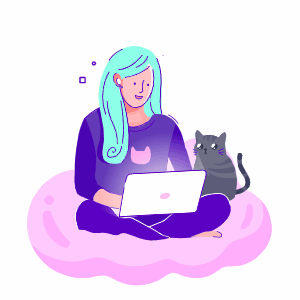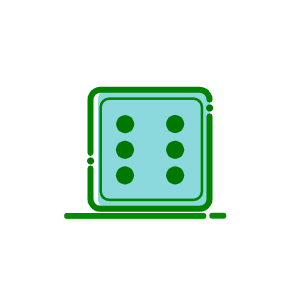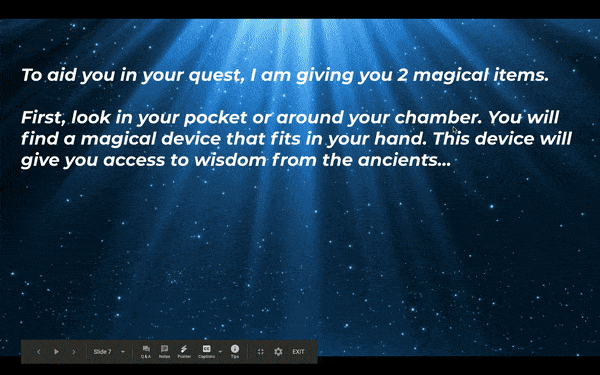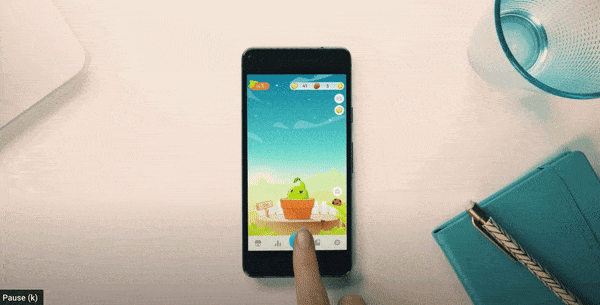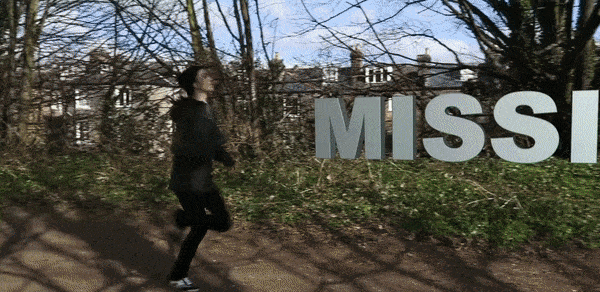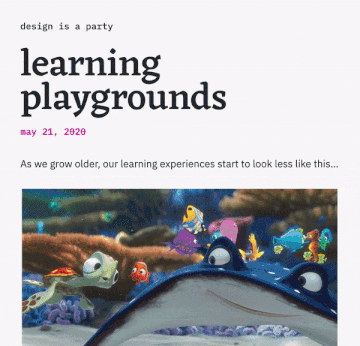Issue 3: Play
The Delightfulness Project is a monthly newsletter exploring what makes products delightful. For future updates, subscribe here.
Hello readers! 👋
A few months ago, a client asked me to unveil their org’s new website, a gorgeously redesigned learning platform for criminal justice professionals. “We really want to show them how helpful the new content is, and how much easier it is to find information,” our client said in our planning call. “But we also want it to be super engaging!”
The presentation would be an hour to a group of 47, on the last day of a 2-day virtual conference. Oof. 😬 I could already see the inevitable Zoom fatigue- glazed eyes 😴 and a wall of black screens. But knowing how to use this site was critical for this audience. So how to make it engaging?
💡The answer: by making it seem like play. 💡
In This Issue
A definition of play and how to apply it to your work and products.
Hear from designer & educator, Elizabeth Lin, on bringing play into design.
Articles & resources to inspire your learning journey.
Animations courtesy of Rizwan Babar and UI8
Why Play?
An overview of play- what it is and product examples. 📖
The idea of folding play into work is an old one. According to Dr. Gilbert Highet, a Classics professor at Columbia:
““The best Renaissance teachers, instead of beating their pupils, spurred them on by a number of appeals to the play principle. They made games out of the chore of learning difficult subjects—Montaigne’s father, for instance, started him in Greek by writing the letters and the easiest words on playing cards and inventing a game to play with them.””
What is Play? 🤔
To me, play is a ⚡burst of energy⚡, usually accompanied by curiosity and a desire to explore. Johan Huizinga, a Dutch cultural historian, defines play as an activity that is:
🕊️ Freeing: A voluntary exercise that allows for free association.
🆕 Outside the ordinary: A release from societal, political, or cultural norms.
😲 Uncertain: A space that allows for creativity, surprises, and spontaneity.
📖 Guided by rules: Whether free play or controlled play, there is a set of guidelines that all participants agree too. Usually, having some constraints leads to higher creativity.
👻 Fun: Elicits a positive mindset, which allows for more creative thinking.
All forms of play share the above elements, but play can take on many different styles. Roger Callois, a French sociologist, further expanded Huizinga’s definition with the following types of play:
Competition
Set rules with equal chance of success
Chance
Games with no control over the outcome
Simulation
Make-believe; pretending to be someone else
Vertigo
Thrilling and disorienting
Above animations courtesy of the community at LottieFiles
These categories were further refined by placing games on a sliding scale from free (using instinctive improvisation) to ordered (requiring calculated skill). Below is an example ⤵️
Applying Play to Work 👩🏾💻
When selecting a form of play for a situation, think about what outcomes you’re trying to achieve.
For my client presentation, we wanted everyone to be able to 🌟experience🌟 the new usability of the platform. At the same time, we had to facilitate 40+ people in 60 minutes. This meant a simulation-style game, with constraints to keep order. To keep people engaged, the game had to be surprising, and far enough outside the ordinary, so that participants would agree to a narrow set of rules.
In thinking of games that allowed people to discover and explore, I decided to create a classic choose-your-own-adventure quest. 🧙🏽♂️
Set in a medieval fantasy world, the client’s website was recast as a magical, omniscient book of knowledge 📖✨ that would guide users through a series of challenges. At each stage, we encountered new enemies, from hedge knights to trolls to dragons, asking tricky riddles which could only be solved by each person hunting through the website to find the right answer.
By disguising the site walkthrough as a game, each person was able to individually experience the usefulness of the website’s content and see how easy it was to find information-- skills which they could then share back (in real life) to their team. Not only was this an effective way to teach a new behavior; it also made a straightforward site both memorable and delightful. 💖
Self-Check ✅
When was the last time you brought play into work? Here are some examples of ways to infuse common work activities with quarantine-friendly play-- give them a try!
💬 For team intros or status updates, try a playful simulation: Have each person introduce themselves from the perspective of their pet! 🐈 Or have each person first act out what they did, with the rest of the group guessing, before they actually share their status update.
🧑🏿🤝🧑🏾 For any group activities or brainstorming, try a playful competition: Split the group into teams of 2-4 people. Using breakout rooms or separate meeting rooms, give each group 5 minutes to come up with as many ideas💡as possible. Come back to the main meeting room and share out each brainstorm. The team with the most ideas wins!
⌛ For a break in-between meetings, try some playful vertigo: Crank up your favorite song. 🎶 Stand up, away from your desk, and vigorously dance out your feelings for the entirety of the song. 💃🏼
Play in Products
Examples of how play creates delight in products. 💞
In psychology, play has been found to help people learn, connect & socialize.
In products, these same benefits also apply, but in a more focused manner. Every product has a specific goal that a user is trying to achieve, features that the person can use to accomplish their goal, and some type of feedback to indicate how close the goal is. When products are playful, this engagement loop becomes inherently fun & attractive, making user engagement absolutely irresistible. 💫
Example: Bounty Tasker 🕹️
Bounty Tasker is a fun & playful app that reimagines the classic to-do list as a fantasy adventure game. ⚔️
Like most to-do apps, Bounty Tasker allows you to set daily, weekly, and monthly tasks in a checklist to be completed. A reminders feature integrates into your phone’s push notifications; you can also tag and filter tasks for easier navigation.
To make tasks playful, you begin by creating your own hero character, who will encounter powerful monsters. To defeat them, you must complete tasks so that you can maintain your health ❤️, uncover new equipment 🛡️, and increase your strength 💪🏿.
Though the app has some bugs to work out, what I like about it is how strongly it incorporates play. Bounty Tasker is voluntary to download, outside the ordinary of our everyday task load, full of uncertain monster encounters, fun, and is guided by rules-- you must complete your tasks to progress.
🙋🏻 But wait, isn’t this just gamification?
It’s more than that! Gamification is a tactic that product designers use to drive user engagement by incorporating game elements, such as badges, leaderboards, and a point system. Often, gamification is used to prod users into taking a specific action.
In contrast, playful design defines an environment and constraints, and then invites users to explore and discover its functionality on their own. By allowing users the ability to define how they want to interact, this allows for higher long-term engagement. Playful design is not only fun and delightful; it’s also more effective in the long-run.
2 More Playful Products
⤷ Video snippet courtesy of Plant Nanny
Plant Nanny (above) is an adorable app that prompts you to drink water daily by reminding you to water your virtual garden of plants! As you hydrate yourself (and them), your plants stay healthy, and you are able to cultivate a garden of happy, well-watered plants!
⤷ Video snippet courtesy of Zombies, Run!
Zombies, Run! (above) is the app that originally got me-- a bonafide couch potato-- into running. Open the app at the start of any run (along with your music), and you’ll be treated to an audio adventure about life as a supply runner after a zombie apocalypse. Periodically, zombies will chase you in this app, and when that happens-- all that’s left to do is RUN!
Self Check ✅
Take a deep breath— phew! That was a lot!
For my product managers, designers & developers, I encourage you to look at your own products:
What are some ways that you can use principles of play in your product?
Are there places where usage is low? How can you reimagine those areas as an interaction that is fun, surprising, and outside the ordinary?
Especially nowadays, when people are forced to use technology to interact with others remotely, we can all use more experiences that challenge us to think in new ways and simply… play.
Conversations with Creatives
Advice from inspiring creatives in the industry.
Got your play principles down? Then let’s hear from this month’s leading creative:
Elizabeth Lin
Elizabeth Lin is a senior product designer and educator who has inspired many (including myself!) with her ability to infuse play, design, and art into her work in incredibly creative ways. Formerly a design instructor at Lambda School, Elizabeth is now a Founding Designer at Primer, where she’s working to reimagine the next generation of kids education — starting with homeschoolers.
I recently sat down with her to hear about her thoughts on playful design.
Learning & Inspiration
Articles, online communities, and other resources to elevate your product skills.
For graphic designers & visual artists,
The “Graphic Design Play Book” is a highly original introduction to graphic design, using puzzles, matching games, and activities to demonstrate how typography, signage, posters and branding work! A gorgeous add to any coffee table or as a present to your favorite designer.
For (online) educators,
Elizabeth Lin, this month’s spotlighted creative, shares her advice on creating “learning playgounds”, based on her experiences as a design educator.
An informative and inspiring read for anyone who loves learning and teaching!
For design lovers & graphic artists,
This “Digital Arts” article showcases some beautiful and visually stunning examples of playful graphic design.
For interior designers & environmentalists,
Richard Hutton, a Dutch designer, shares his perspective “On Sustainability, Environmentalism, and the Power of Playful Design”. As Hutton says, “Play is the essence of everything I do. For me, living is playing”.
For product & design scholars,
Get an in-depth look into playful design with Paul Rand’s presentation on “Design and the Play Instinct”. Covering uniquely beautiful examples of play, from Chinese tangrams to Byzantine mason marks, this is a fascinating look into the intersection of art, history, and play.
Final Thoughts
Play is an innate, universal desire for every person. When we’re in a relaxed state, our minds expand and we’re more likely to create, explore, and experiment.
When brought into products, play prompts users to discover and redefine products for themselves, creating uniquely meaningful experiences. Playful design encourages us to push our boundaries, combining new processes, ideas, and actions into a reimagination of what’s possible. It’s irresistible. And, of course, delightful.
Share the Love 💞
Know some other product enthusiasts that might enjoy this month’s topic?
Share this issue on Facebook, Twitter, or LinkedIn.
And if you’d like to be reminded of upcoming issues, subscribe to get new issues straight to your inbox.

